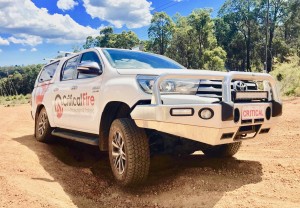 Critical Fire Protection & Training delivers professional training which results in Nationally Accredited 4WD qualifications.
Critical Fire Protection & Training delivers professional training which results in Nationally Accredited 4WD qualifications.
By undertaking this course, employers will have the confidence that their employees have obtained the national competence by demonstrating their ability to operate a 4WD safely and responsibly both from a theory perspective however from a practical perspective.
Elements (These define the essential outcomes)
1. Identify four-wheel drive specific terms, terminology and techniques
2. Plan for minimal environmental impact
3. Perform pre-departure checks
4. Use four-wheel drive mode
5. Coordinate and recover a vehicle
6. Perform maintenance and minor repairs on four-wheel drive vehicles
Performance Criteria (This specifies the level of performance needed to demonstrate achievement of the element)
1.1 Access, interpret and apply four wheel drive vehicle documentation and ensure the work activity is compliant
1.2 Identify the structural and handling differences between a conventional two wheel drive and a four-wheel drive vehicle
1.3 Identify and demonstrate the purpose and use of front wheel hubs
1.4 Identify factors affecting tyre size, fitment, rating, and pressure
1.5 Identify recovery hooks and mounting features
1.6 Identify hazards associated with incorrect use of vehicle features or equipment
2.1 Determine types of impact likely to occur during four-wheel driving activities
2.2 Demonstrate compliance with land management principles and policies when planning exploration activities
2.3 Comply with policies and management plans relevant to the activity area
2.4 Plan and conduct activities in a manner which minimises environmental impact
2.5 Adopt and implement procedures to ensure minimisation of harm to the environment from four-wheel drive activities
2.6 Demonstrate cooperation and consideration towards other land users
3.1 Perform routine pre-departure checks under the bonnet, under the body, on external and internal items and accessories
3.2 Take action to correct any deficiency
3.3 Determine food and water requirements for journey
3.4 Select navigation equipment
3.5 Interpret weather conditions, determine suitability for driving
3.6 Apply safe vehicle loading practices
3.7 Secure items of personal luggage
3.8 Advise passengers of any special safety precautions to be taken when traversing rough terrain
4.1 Operate four-wheel drive both on and off road, in accordance with road rules, principles of four-wheel driving and WHS regulations
4.2 Apply smooth accelerator control strategies over a range of terrain types
4.3 Demonstrate recommended braking techniques for hard top surfaces and off road conditions
4.4 Identify situations where the engagement of four-wheel drive is required
4.5 Engage four-wheel drive mode
4.6 Survey track to identify hazards, asses risk and select a best route
4.7 Select routes to minimise damage to the environment
4.8 Use appropriate range, gear, speed, driving and braking technique, negotiate a range of terrain types whilst maintaining control of vehicle, being aware of contextual/environment issues
4.9 Maintain appropriate hand positioning on steering wheel
4.10 Check brakes and undercarriage after negotiating varying terrain
4.11 Assess and perform repairs to damaged tracks
4.12 Use standard operating procedures when travelling in company with other vehicles
5.1 Apply work procedures to ensure risk assessment, safe operating practices, and communication requirements are adhered to
5.2 Identify equipment and methods to recover a stuck vehicle
5.3 Identify risks associated with vehicle recovery and develop and implement strategies to minimise risks
5.4 Identify correctly rated recovery equipment and attachment points
5.5 Demonstrate procedures for preparing vehicles for recovery
5.6 Identify techniques to minimise impact on the environment during vehicle recovery
5.7 Coordinate safe recovery of a four-wheel drive vehicle using designated equipment and recovery method
5.8 Perform post recovery checks and report any vehicle or environmental repairs needed
5.9 Return recovery equipment to a reusable condition
6.1 Select/access maintenance equipment, including spares and fluids, prior to departure, considering contextual issues of the trip
6.2 Check vehicles prior to and regularly during trip, and perform routine maintenance/repair tasks
6.3 Submit vehicle written performance reports
6.4 Demonstrate safe use of a jack to change a wheel on a four-wheel drive vehicle
Pre-Requisites
Drivers Licence (preferably Manual)
For further information please contact us.
Information above provided by https://training.gov.au/TrainingComponentFiles/RII/RIIVEH305E_R1.pdf
Social Media
Connect with us